- Тема: Малогабаритный Tapped Horn 10* в авто
- Малогабаритный Tapped Horn 10* в авто
- Tapped Horn 18
- #1 nika_sdf
- #2 casto
- #3 Александр40
- Тема: помогите выбрать динамики для сабов tapped horn
- помогите выбрать динамики для сабов tapped horn
- Tapped horn своими руками
- Tapped horn своими руками
- Predicted V’s Measured Performance of Tapped Horns
- Modelling a Tapped Horn
Тема: Малогабаритный Tapped Horn 10* в авто
Опции темы
Малогабаритный Tapped Horn 10* в авто
Вроде такого на веге еще не выкладывали, поэтому решил поделиться.
Идея была сделать бюджетный и главное музыкальный сабвуфер в авто. Так как мне нравится подача баса от «про» динамиков, то сразу начал смотреть в их сторону. Хотелось не очень больших габаритов, поэтому 15* не подходил. С некоторой натяжкой подходил 12* в фазоинверторе, но опять же габариты не детские. Был положительный опыт конструирования «трансмиссионных линий», поэтому начал рыть в этом направлении. В итоге после некоторых прикидочных расчетов по доступным динамикам пришел к данной конструкции.
Tapped Horn 10*, динамическая головка Biema BML-T1002, длинна канала около полутора метра (наполнитель и обивка отсутствуют), сечение — 325 кв.см., материал — ЛДСП 18мм. Размеры (ШхГхВ): 300х300х750 мм.
Конструкция делалась лет 5 назад, поэтому чертежи и распил не сохранились, но если нужно будет кому, то постараюсь сделать.
В эксплуатации сабвуфер показал себя великолепно. Корпус надежный и весьма практичный. Очень хорошо переносит перегрузку. Не требует мощного усилителя. При максимальной мощности 100Вт создает порядка 125дБ (расчетных, в реальности, в замкнутом пространстве автомобиля, может быть еще больше). На слух, «в полку» отыгрывает от 40Гц. И самое главное: такого быстрого, тактильного и одновременно низкого баса я ни в одном авто не слышал! Играет отлично все, кроме «негров». Особенно интересен рок, один в один как на концерте. Если вы когда-нибудь стояли рядом с эстрадным сабвуфером, то вы меня поймете . Но самый конек — это клубная музыка!!
Источник
Tapped Horn 18
#1 nika_sdf


хочется собрать Tapped Horn 18 ,но не имею детальных чертежей
также интересно если кто нибудь сравнивал Tapped Horn 18 VS Mini Scoop
у самого 4шт Mini Scoop , хочется более компактные и эффективные сабы
#2 casto




хочется собрать Tapped Horn 18 ,но не имею детальных чертежей
также интересно если кто нибудь сравнивал Tapped Horn 18 VS Mini Scoop
у самого 4шт Mini Scoop , хочется более компактные и эффективные сабы
#3 Александр40

Источник
Тема: помогите выбрать динамики для сабов tapped horn
Опции темы
помогите выбрать динамики для сабов tapped horn
Добрый день, если вам не трудно помогите определится с динамиками для tapped horn 15, первоначально планировалась бюджетные динамики LF15X401, но их надо ждать достаточно долго, есть в наличие более дорогие неодимовые динамики LF15N451
Интересно имеет ли право LF15N451 жить в кабинете tapped horn ?
У неодимовых БЛ гораздо больше 33,5 / 26.6 но xMax меньше 8,7 / 11,2
ps планирую построить 8 шт по 4 на сторону.
THIELE/SMALL PARAMETERS —LF15N451
- Resonance frequency:35 Hz
- DC resistance:5.1Ω
- Mechanical factor:4.2
- Electrical factor:0.19
- Total factor:0.18
- BL Factor:33.5 T · m
- Effective Moving Mass:171 g
- Equivalent Cas air load:125 liters
- Effettive piston area:0.091 m²
- Max. linear excursion (mathematical):8.7 mm
- Voice — coil inductance @ 1kHz:2.6 mH
- Half-space efficiency:2.64%
THIELE/SMALL PARAMETERS —LF15X401
- Resonance frequency:34 Hz
- DC resistance:5.5Ω
- Mechanical factor:7.6
- Electrical factor:0.30
- Total factor:0.29
- BL Factor:26.5 T · m
- Effective Moving Mass:170 g
- Equivalent Cas air load:146 liters
- Effettive piston area:0.091 m²
- Max. linear excursion (mathematical):11.5 mm
- Voice — coil inductance @ 1kHz:2,5 mH
- Half-space efficiency:1.90%
Источник
Tapped horn своими руками
Долго ли коротко, стал наконец обладателем сего девайса. Сложность, в приобретении, как раз связана с тем, что хотелось именно активный вариаант, а это значит, чуть ли не индивидуальный подход в изготовлении корпуса! Но всё позади, и теперь есть саб, состоящий:
— достаточно качественный кабинет от Sanshes
— парковский усилительный модуль DX1400MB
— сабовая голова EighteenSound 15NLW9500
Пожалуй, уже нет особой необходимости говорить о преимуществах Tapped Horn, но так получилось, что у меня в работе есть Mackie SWA1501, то поневоле напрашивается сравнение. Может кому-то и помогу своим сообщением.
Итак, сказать, что «мэком» я недоволен, конечно нельзя. В моём, «китайском» образца 2008, электроника и динамик уже не «те» (у коллег ещё америкосы, так там всё чики-пуки), но несмотря на это, SWA1501 в небольших помещениях и где-то до 50- ти человек, под мои задачи, своё отрабатывает. Вот и понадобился мне, на бОльшие залы и бОльшее кол-во публики, более мощный саб, а требования прежние — максимально компактный размер и малый вес. Из переписки с изготовителем (Sanshes), цитирую: «Сделано всё очень аккуратно. Очень усиленное горло — 2-мя распорками. Я сумел ЕЩЁ уменьшить размер кабинета и он получился 680x610x490, . корпус очень классный получился.»
Саб, можно сказать, пришёл вовремя — ближайшая свадьба в зале примерно 20 х 20 м потолок около 8-9 м (короче, чтоб лучше представить — зал похож на крытую волейбольно-баскетбольную площадку, одно что трибун нет 
Вобщем, если коротко, выводы на сегодня пока такие:
— ТН 15″оправдывает своё название — сабвуфер!
— усилительный модуль (в этом ящике и с имеющимся дином) показал себя великолепно — не греется ВАЩЕ! (в этом убедился уже до работы, т.к. «гонял» усилок длительно на полной мощности)
— вес, по мне, получился приемлемый, во всяком случае не тяжелей Mackie SWA1501
— ну и капля дёгтя — без кроссовера (или подобной приблуды) по-моему не обойтись, крутил на испытаниях так и эдак ничего путнего не извлёк — каша! (хотя, может опыта маловато). Тогда подцепил топы RCF ART300a через простенький берх (типа такого — Behringer CX 2310 Super X Pro), подобрал срез на модуле и на кроссе — зазвучало удовлетварительно, так потом свадьбу и отработал, звук меня вполне устроил.
Итого, в сухом остатке (напоминаю, что речь идёт о разъездной работе):
— Mackie SWA1501 — очень компактный, универсальный, достаточно мощный активный сабвуфер — остаётся для меня пока основным «рабочим» вариантом, потому что подавляющее кол-во банкетов проходит в небольших залах и гостей часто не более 40-50 человек.
— Tapped Horn 15″ актив — отличный чёткий бас, замечательное давление, менее капризен к архитектурным особенностям зала, общее «покрытие» звуком более ровное. Также можно отметить относительно небольшой вес (в сборе около 40 кг), немного больший объём корпуса по отношению к SWA1501.
Планирую использовать по необходимости (всё-таки внешний кроссовер — это дополнительный прибор, дополнительная коммутация, дополнительная розетка и даже дополнительное время на подключение 
Отдельно, ещё раз, хочу поблагодарить форумчан, которые так или иначе меня консультировали и оказывали разного рода помощь по приобретению сабвуфера: seregan1, Sanshes, PAV 75, tda-audio, ГенаЛог, КП, Бондарь игорь валерьевич, Владимир 57.
Добавлено через 21 минуту
[Ссылки могут видеть только зарегистрированные пользователи. ]
[Ссылки могут видеть только зарегистрированные пользователи. ]
[Ссылки могут видеть только зарегистрированные пользователи. ]
__________________
Кому нравится арбуз, а кому — свиной хрящик
[Ссылки могут видеть только зарегистрированные пользователи. ]
не продам субовый динамик Beyma 15G450N
Источник
Tapped horn своими руками
There has been much talk on many of the DIY audio forums about the tapped horn. This design was recently made popular by Tom Danley at Danley Sound Labs. Tom is responsible for designing the the best performing tapped horns to date. The bandwidth he achieves in his products is as good as I have seen. It is a real juggling act between the driver and the horn to get a broad and flat response. Tom’s TH115 is as good as it gets. Interestingly enough, there are many similar designs that were developed decades earlier, such as the Jensen Transflex and the JBL Air Coupler which used the 2245H driver. US Patent #5177329 shows a similar design. I would have to assume performance was poor because there are no published response plots (to the best of my knowledge) and the design quickly fell from favour. Many people are speculating and discussing the tapped horn at length, but with few exceptions in the DIY world, has anyone made some sawdust and actually built one. Through 2006 I was involved in a thesis project which attempted to accurately model the tapped horn. Many prototypes were built and many iterations of these prototypes were tried and measured. I’ve put together some of our findings here for discussion.
| The first tapped horn we built was this 60Hz version. This cut off was chosen for economy of timber and ease of manufacture. It was initially designed around the Eighteen Sound 10W400. This driver appeared excellent for this application, and the guess was right. Out of all the horns we built, this one had the flattest bandpass and the greatest frequency range, being essentially dead flat from 50 to 260Hz. | 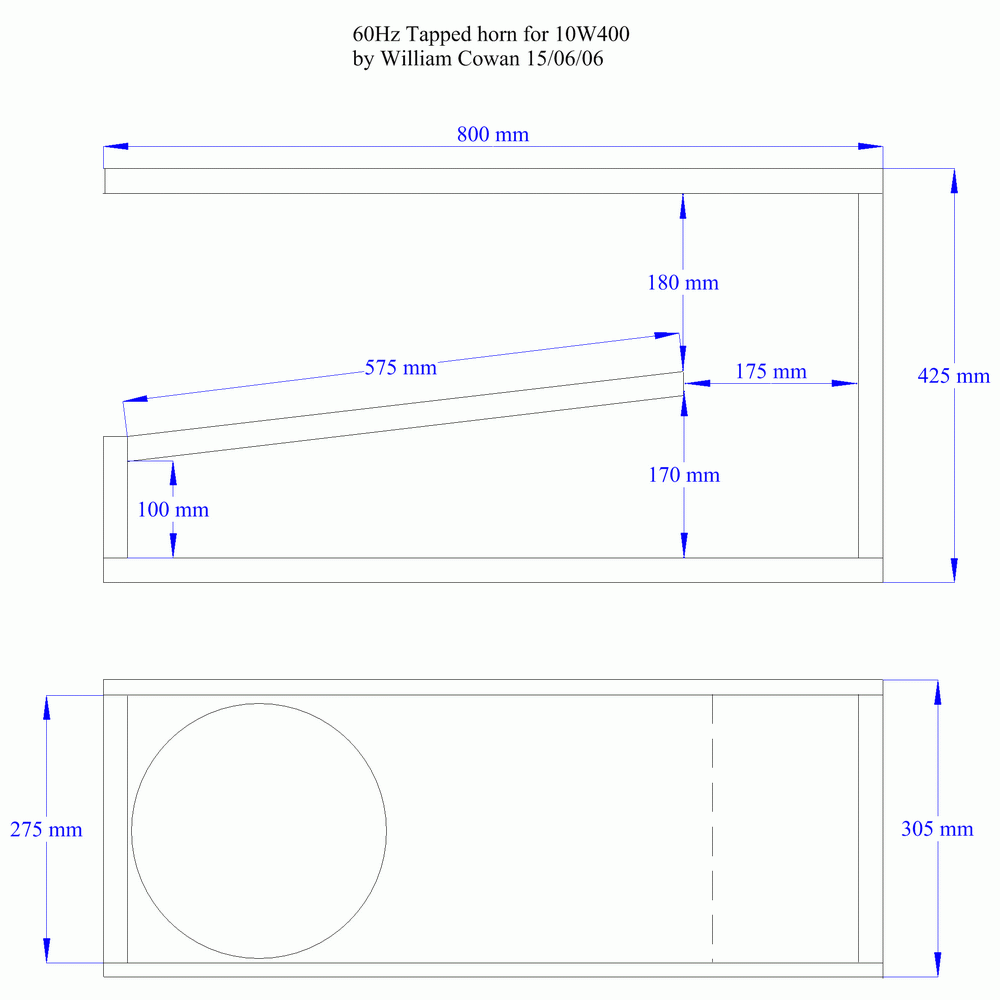 |
| Here the driver is being moved up the horn, away from the mouth and throat. |  |
| This plot shows the results of two different drivers being tested in this 60Hz tapped horn. | 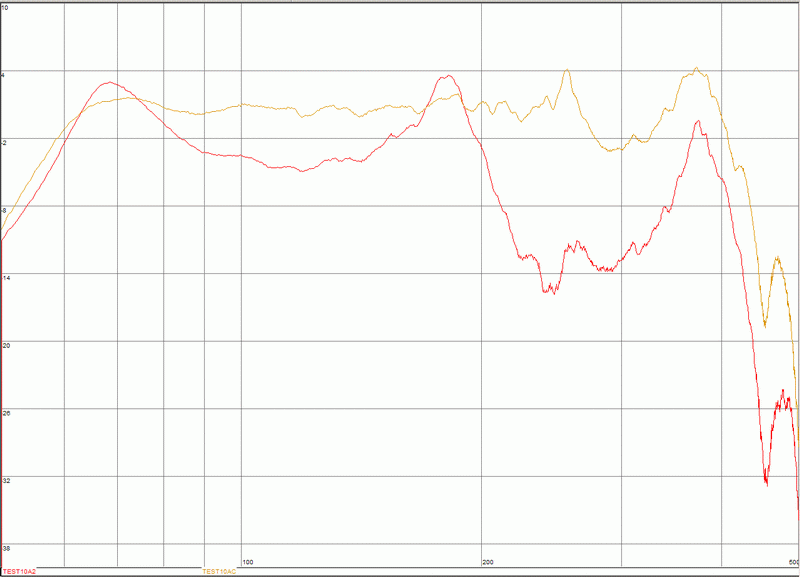 |
| The second tapped horn was essentially a scaled up version of the 60Hz horn. A more suitable driver was chosen for the frequency range of interest. This horn was used as a subwoofer in my main home system for a while, and now resides in my second system. The output this horn is capable of in a package one person can carry is quite astounding. | 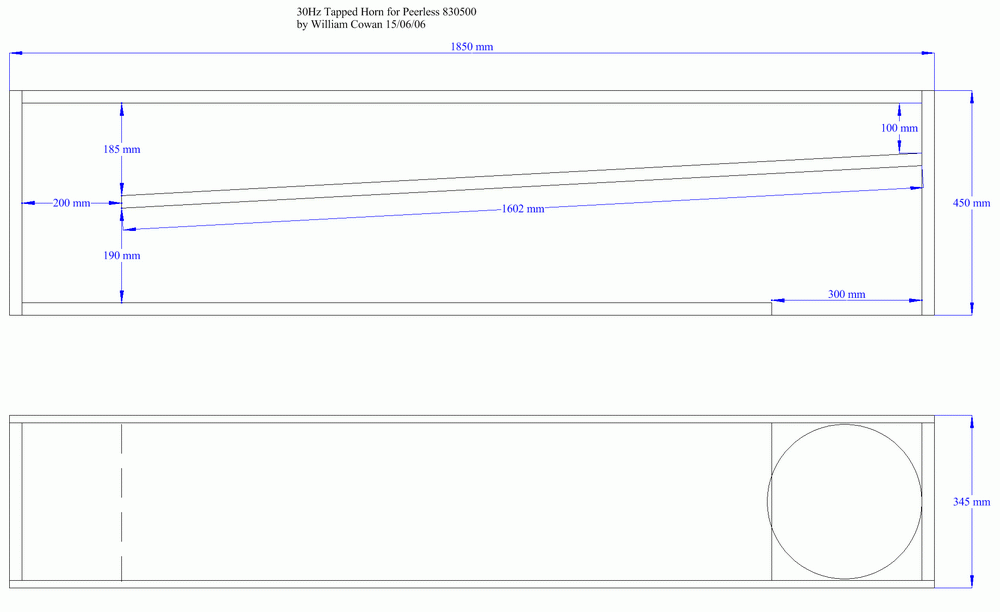 |
| This plot shows the results of two different drivers being tested in this 30Hz tapped horn. | 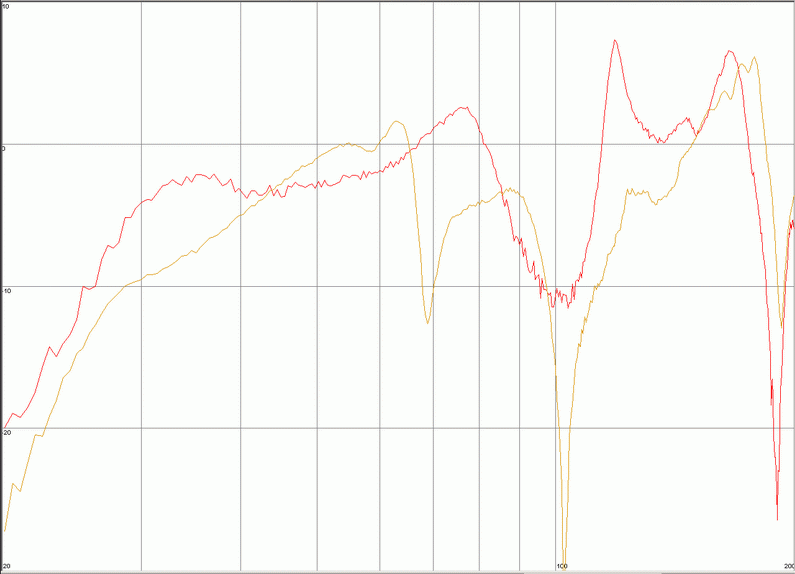 |
| Inside the 30Hz Tapped Horn. No bracing in this picture. | 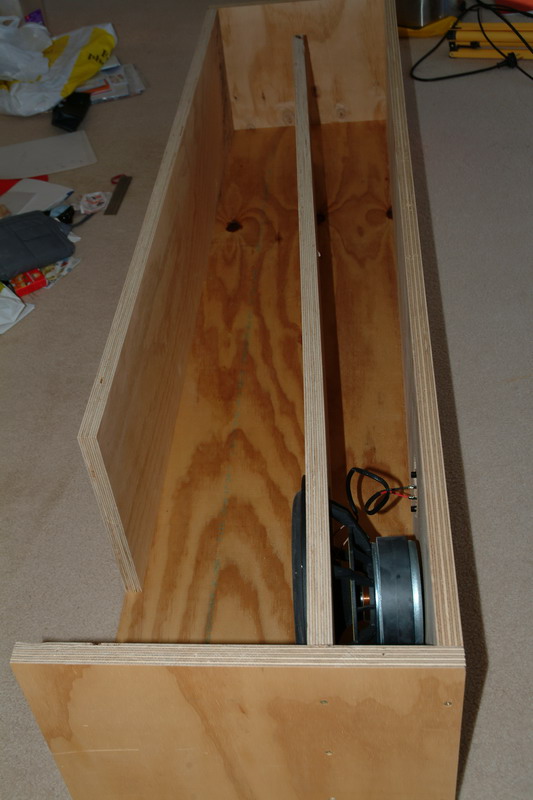 |
| Anyone who wants to make a great little tapped horn similar to this one should make a few changes. The slope of the baffle should be increased so that the throat end measurement is 48mm, giving a 150cm^2 throat. Combined with a Peerless 830564 XLS driver, I measured a flat response from 30 to 100Hz and more than 130dB output with 400W of drive, when firing from a corner. In half space the maximum output will be around 122dB at 1M and 400W. To get a feel for what this is like, it would take four 830847’s in a 350 liter sealed box driven with 1200WRMS to achieve the same output as this 165 liter box with one driver at 400WRMS. The tapped horn has more output than the four driver sealed box right down to 20Hz. The Peerless 830564 is a very suitable driver in a 30Hz tapped horn, with it’s 49Hz resonant frequency, good excursion and strong cone assembly. Here’s a photo into the mouth of the 830564 version of the 30Hz Tapped horn. The driver will have to be mounted this way around to fit the magnet in. |  |
| Looking in the mouth of the new 30Hz Tapped Horn. |  |
| The 18Hz, 30Hz and 60Hz Tapped Horns | 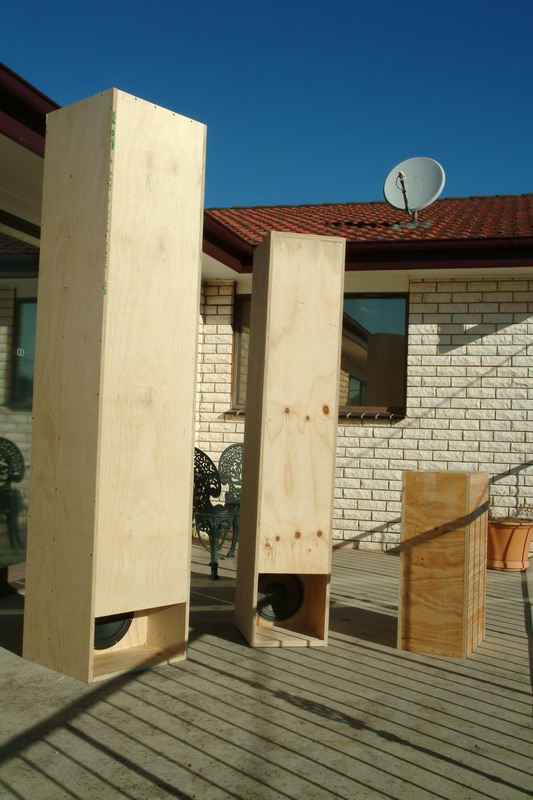 |
Predicted V’s Measured Performance of Tapped Horns
| There has been a lot of discussion on the diyAudio forums on the Collaborative Tapped horn project about modelled versus predicted response of Tapped Horns. In this example I will show a model of a 35Hz tapped horn, and compare it to the measured response. | 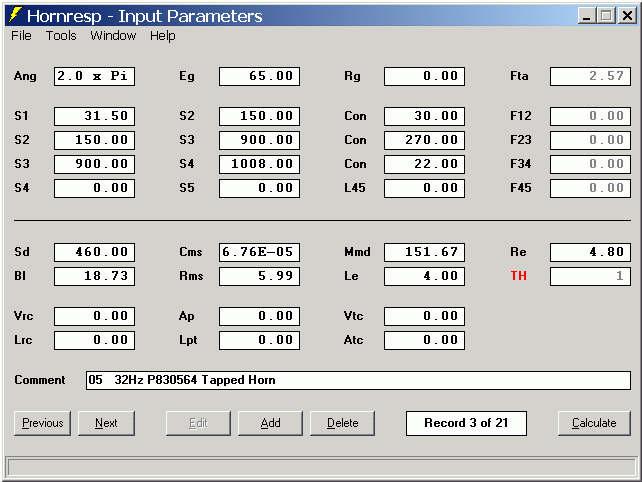 |
| Here is the predicted response for this 35Hz Tapped Horn. The 56V RMS input power level was chosen because this corresponds with the power available from the power amplifier that drives these Tapped Horns. |  |
| A drawing of the construction of this Tapped Horn. It is a simple single fold horn with a straight sloping driver baffle. No stuffing or lining was used in this construction. | 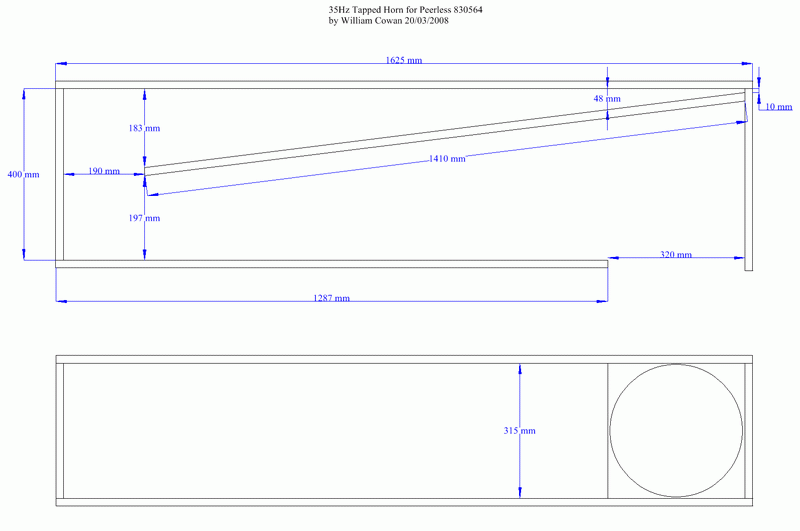 |
| The measured response of the Tapped Horn. This measurement was taken with my IMP/MLS using no smoothing, taken at the mouth. You can see that the measured response of this tapped horn corresponds very well with the predicted response generated by HornResponse. The Q of the out of band resonances is slightly lower than predicted. If the horn path was lined with absorbant foam, or similar, the Q of the out of band resonances would have been even lower, also reducing their amplitude. I chose not to line the horn path because the desired final response could be easily obtained with the DCX2496 that was doing crossover duties. In use I was unable to get more than 12-15mm of peak-peak excursion from the driver when driven with an amplfier that was close to clipping at peaks of more than 500W RMS. When trying a particularly brutal Slayer track with lots of very fast kick drum the smell of hot voicecoils became quite obvious. The thermal limits of the driver became a problem well before the 25mm peak to peak xmax. |  |
Modelling a Tapped Horn
By far the easiest way to accurately model a Tapped Horn is to download and use the excellent HornResponse program written by David McBean. He has invested a huge amount of time developing what is arguably the best horn loudspeaker modelling software available, and it’s free! If you want to incorporate features into your design that HornResponse doesn’t allow, you will have to resort to a package that is a litte more flexable such as AkAbak. Many thanks to David for showing me how to simplify the AkAbak script for a tapped horn. You can copy this script and paste it into AkAbak and adjust the constants for the horn and driver to suit your proposed design and then run the simulation. If you model a few different drivers in the 30Hz tapped horn, you will see that several perform better than the 830500 used in this model. HornResponse will also allow you to export files for use in AkAbak.
| | 30 Hz Tapped Horn Def_Const |Horn Dimensions < Sd=466cm2 Driver Def=’Dr1′ Node=1=0=3=4 Источник |